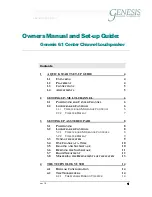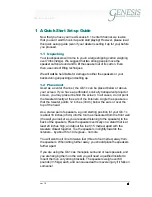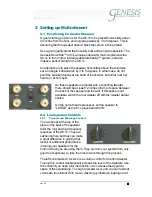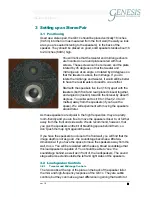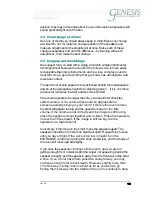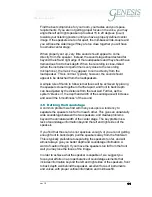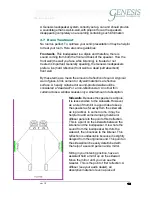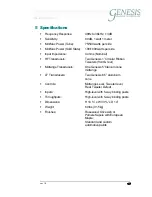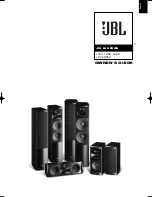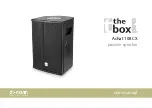
ver 1.0
15
15
15
15
~ÄëçäìíÉ=ÑáÇÉäáíó
ribbon/electrostatic designs, without the high distortion and poor
dispersion that is typically associated with them.
The G6.1c uses two of these tweeters per channel. One is front-firing
and the other rear-firing; wired to the crossover out of phase to the front
tweeter, creating a dipole.
4.2.2 Titanium
Midrange
We sometimes say that the midrange is a window into the mind of a
composer or a singer. And indeed, the midrange is where the “magic” is
in a well-recorded musical event.
The G6.1c uses a Genesis-designed proprietary 5 inch titanium-coned
midrange to cover this critical frequency spectrum. Manufactured out of
one of the lightest and stiffest materials known, this low mass cone
driver is one of the best midrange transducers ever made, with nearly
instantaneous transient response, enabling the G6.1c to sound lifelike
and effortless.
4.2.3 Aluminum-cone
Woofers
The G6.1c incorporates two front-firing 6.5 inch metal cone woofers.
Made of a cone of solid aluminium, the suspension and voice-coil have
been maximized for long, distortion-free excursion so as to increase
dynamic range. Our aluminium cones are a magnitude stiffer than
plastic or paper cones, and virtually eliminate the problems caused by
cone bending and break-up.
4.3 Crossover
If the servo-controlled bass amplifier is the heart of the loudspeaker, the
crossover is the brain. In order to manage and maximize the
performance of the extensive complement of transducers used in
Genesis loudspeakers, we spend more money on the crossover than
many other manufacturers put in their entire speaker.
Each crossover is designed by computer modelling plus years of
knowledge and experience. The inductors are made for Genesis with
OFC copper windings. The capacitors used are also custom made for
Genesis, using high-quality polypropylene-film and tin-foil. The
crossover of each G6.1c weighs over five pounds (2.2kg)! L/C tuning is
employed to extract the most bass out of the small cabinet.
More importantly, the crossovers are designed with many, many hours
of music listening and constant refining, tuning and tweaking of the
circuit. Out of this comes the “magic” that is a Genesis-designed
loudspeaker system. For example, by going the more expensive route

